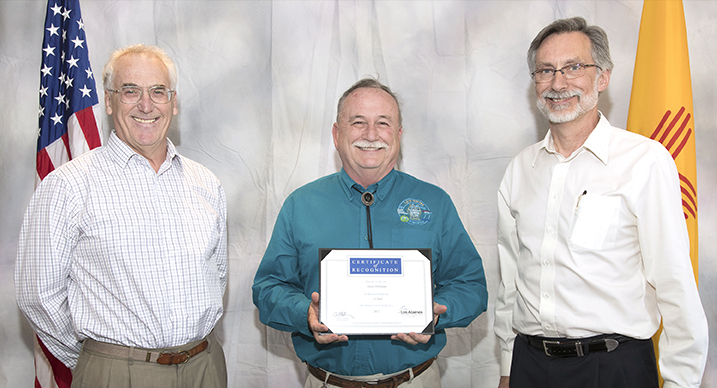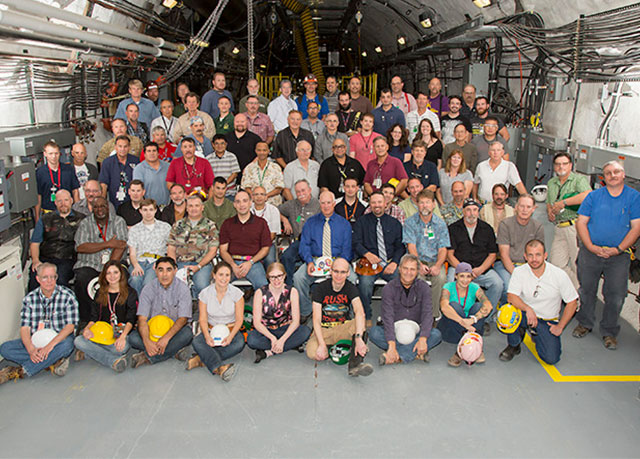Being Agile: David Holtkamp
Lab Character: Who We Are

David Holtkamp
Editor’s note: David Holtkamp passed away June 16 after retiring from Neutron Science and Technology (P-23) earlier in the month. He was interviewed just prior to his retirement.
Deciphering the code
As a youngster in small-town Texas, David Holtkamp was a ham radio enthusiast with a passion for transmitting Morse code around the world, much to the dismay of his neighbors. “My little, poorly built 40-watt transmitter would interfere with TVs for blocks around,” Holtkamp said.
Little did Holtkamp imagine that his interest in tinkering with electronics would lead to a varied and satisfying career in nuclear physics—one that included 35 years at Los Alamos National Laboratory and numerous distinguished contributions to the Lab’s national security science mission.
Yet the signals were clear. As an interdisciplinary honors student at the University of Texas (UT) at Austin, Holtkamp took a part-time job helping with low-energy nuclear experiments on the Physics Department’s tandem accelerator. When some UT professors began exploring the medium-energy nuclear physics available at the Los Alamos Meson Physics Facility (now the Los Alamos Neutron Science Center), Holtkamp came along as a summer student. He later earned a PhD in physics from UT and joined the Laboratory staff in 1982.
Holtkamp received two Laboratory Distinguished Performance Awards, two Defense Programs Awards of Excellence and two R&D 100 Awards. The first R&D 100 was for the Multiplexed Photonic Doppler Velocimetry (MPDV), a diagnostic technology allowing researchers to gather shock physics data in unprecedented detail. The second stemmed from the Miniature Elastic Backscatter Lidar, a remote sensing technology based on a device created in 20 days for the United States’ efforts in the Gulf War (see “David Holtkamp’s favorite experiment”).
Lab Character
Watch for more profiles of Lab employees who exemplify the nine positive character traits that personify who we are, past and present:
- Innovative
- Agile
- Passionate
- Responsive
- Tenacious
- Trusted
- Principled
- Scientific
- Iconic
Discover more about your colleagues and gain insight into their journeys . . .
For two decades, Holtkamp contributed to the country’s subcritical nuclear testing program at the Nevada National Security Site, which safeguards the nation's nuclear stockpile without conducting nuclear tests. For these small scale, underground experiments, Holtkamp served as diagnostic coordinator for the Lyra series, collaborating with scientists who developed the high-tech diagnostics and who analyzed the experiments’ resulting data. Lyra’s last shot, Vega, will take place later this year with new diagnostic coordinator Chris Frankle (P-23) at the helm.
Performing multidisciplinary, complex work across multiple organizations is challenging, yet Holtkamp said, “There’s such a variety of expertise and intelligence here. It’s a wonderful time of innovation.”
He highlighted the MPDV project, a joint effort that included National Security Technologies LLC and Lawrence Livermore National Laboratory, as an example. “It revolutionized the quantity and quality of data obtained in hydrodynamic experiments,” he said.
Science Program Deputy Program Director Michael Furlanetto (Associate Directorate of Weapons Physics, ADX), seconded Holtkamp’s opinion. “MPDV is now the standard diagnostic on implosion experiments at LANL, and both Lawrence Livermore National Laboratory and the Atomic Weapons Establishment are moving in the same direction,” Furlanetto said. “When the Dual Axis Radiographic Hydrodynamic Test Facility asked me to lead the development of a new generation of MPDV . . . the first person I asked for help was David, and it was his deep understanding of MPDV that put us on the right technical path.”
 PADSTE Alan Bishop, left, and Director Charles McMillan (right) congratulate David Holtkamp on 35 years of Laboratory service.
PADSTE Alan Bishop, left, and Director Charles McMillan (right) congratulate David Holtkamp on 35 years of Laboratory service.In Memoriam
David Holtkamp passed away June 16 after retiring from P-23 earlier in the month. He is survived by his wife, Irma, a retired Laboratory librarian and longtime genealogy researcher. He has two children, David Michael and “Katy,” and two grandchildren.
“It's hard for me to imagine Los Alamos without David,” Furlanetto said. “His scientific contributions, his varied interests and his strong personality made him almost a larger-than-life figure. I think everyone who worked with him feels the hole left by his absence.”
David Holtkamp’s favorite experiment
What: Although our recent work with the subcritical experiments in Nevada has been extremely satisfying, one of the career activities that I’m most proud of is helping build the Lidar for Desert Storm in the Gulf War. We were challenged to build an airborne volume-imaging Lidar, test it and deploy it in a matter of a few weeks.
When: In 20 days, over the 1990 Christmas holiday.
Where: TA-3
Who: The core team was maybe a dozen people, but the whole team included people from all over Los Alamos, including the Physics, Chemistry and MST divisions.
How: Because the instrument had to be built so quickly, we couldn’t use the normal design/fabricating/testing methods. We took an old water heater from TA-35 to use as a telescope, and ended up putting all the pieces on a pallet that you could slide into a C130, the plane it was designed to fly on. We worked as close to 24 hours a day as possible, seven days a week. It’s the closest I’ve come to how the scientists must have felt during the heyday of the Manhattan Project, and it enormously increased my admiration for what they did.
 David Holtkamp and members of the the shot team in March the day before the Eurydice experiment,
David Holtkamp and members of the the shot team in March the day before the Eurydice experiment,which was part of the Lyra subcritical series at the National Nuclear Security Site.





